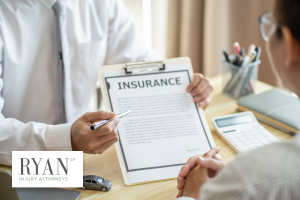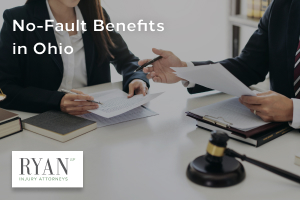
When you’re involved in a car crash in Ohio, it’s crucial to understand how the state handles these incidents. Ohio is not a no-fault state but follows a traditional fault-based system for resolving car accident claims. This indicates that the person responsible for the accident is also responsible for the damages. Knowing whether Ohio is a no-fault state helps you navigate the aftermath of a collision more effectively. At Ryan Injury Lawyers, our car accident lawyers can help you after an Ohio auto accident.
In a fault-based system, the injured parties can pursue compensation directly from the insurance provider of the driver responsible for the incident. They can file a claim with their own or the other driver’s insurance or take legal action in court. Knowing the difference between a no-fault and an at-fault state is crucial for anyone involved in a car accident in Ohio. See a doctor for your car accident injuries first. Then, schedule a free consultation with our car accident lawyer.
Ohio’s Legal Framework for Car Accidents
Ohio’s legal approach to handling car accidents is straightforward: the state uses a fault-based, or “tort,” system. This system requires the party at fault for causing the accident to compensate the other party for their losses. This could cover medical bills, lost pay, and property damage. Identifying who is at fault plays a significant role in the process, directly impacting who pays for the damages.
The fault-based system encourages drivers to act responsibly to avoid financial liability. In Ohio, drivers must carry minimum liability insurance to cover potential damages in an accident where they’re at fault. This insurance is crucial because it provides financial protection for drivers who cause accidents. Furthermore, the system allows for flexibility in resolving claims through insurance settlements or court judgments. Reach out to us if you have questions about minimum liability insurance.
Understanding No-Fault Insurance

No-fault insurance is a system where drivers file claims with their own insurance companies for injuries after an accident, regardless of who caused it. This system aims to speed up compensation for injuries without needing to determine fault. In no-fault states, personal injury protection (PIP) coverage is a key component of auto insurance policies.
How No-Fault Insurance Works
Under no-fault insurance, you would file a claim with your insurance company for medical expenses or other covered losses after a car or bicycle accident. This process is designed to ensure that you receive prompt payment for your injuries. No-fault insurance typically limits your ability to sue the other driver involved in the accident. This system aims to lessen the number of lawsuits stemming from car accidents, focusing instead on quick and efficient compensation for those injured.
The primary objective of no-fault insurance is to streamline the compensation process for accident victims. Individuals can avoid lengthy legal disputes over who was at fault by filing a claim with their own insurance. Keep in mind that Ohio is a fault-based state, not a no-fault state.
Advantages and Disadvantages of No-Fault Insurance
Advantages:
- Speeds up compensation. Victims receive payments for their injuries faster since they don’t have to wait for a fault determination.
- Reduces legal costs. By limiting the ability to sue, no-fault insurance can lower the overall costs associated with legal proceedings.
Disadvantages:
- Limited recourse for pain and suffering. No-fault insurance often restricts compensation for pain and suffering, making it difficult for victims to recover fully from their injuries.
- Caps on benefits. Some no-fault policies limit the benefits you can receive, which may not fully cover all medical expenses or lost wages.
Determining Fault in Ohio Car Accidents
In Ohio, determining who is at fault in a car accident is critical in the claims process. Insurance companies assess the accident’s circumstances to decide which driver’s negligence contributed to the incident. This decision affects how damages are awarded and who bears the financial responsibility for injuries and property damage. The fault determination process is thorough, involving collecting evidence and analyzing the accident details.
Ohio’s Fault-Based System
Ohio’s fault-based system allows for flexibility in how car or motorcycle accident victims can pursue compensation. They can initiate a claim with their own insurance company, the at-fault driver’s insurance, or directly sue the at-fault driver in court. This system places the financial burden on the driver who caused the accident. In this system, the driver’s insurance company found to be at fault pays for the damages. This includes covering medical bills, property damage, and sometimes pain and suffering.
Factors Considered in Determining Fault
- Traffic Laws and Regulations. Insurance adjusters look at whether drivers in the accident violated traffic laws. Violations can serve as evidence of fault.
- Evidence From the Accident Scene. Photos, videos, and physical vehicle damage provide crucial insights into how the accident occurred and who is likely at fault.
- Witness Statements. Testimonies from people who saw the accident can describe what they saw from their perspective. This could be used to support your claim.
- Police Reports. Officers who respond to the scene create a report that includes details about the car or truck accident, which can be pivotal in fault determinations.
Comparative Negligence in Ohio

Ohio follows a comparative negligence rule, allowing for compensation even if you’re partially at fault for the crash. However, your compensation is cut by your percentage of blame. For instance, if you’re found to be 20% responsible for an accident, your compensation will be reduced by 20%. This rule encourages fair and proportional compensation based on each party’s involvement in the accident.
No-Fault Benefits in Ohio
Although Ohio is not a no-fault state, drivers can still carry optional insurance coverage, such as MedPay, which offers benefits similar to no-fault insurance. This protection can help cover medical costs after an accident, regardless of who was at fault. It provides a financial safety net for drivers, ensuring that they have access to necessary medical care following an accident.
Personal Injury Protection (PIP) Coverage
Personal Injury Protection (PIP) coverage is not a requirement in Ohio due to its at-fault insurance system. However, drivers may choose to add similar coverage options to their policy for additional protection. These options can cover medical expenses and, in some cases, lost wages after an accident. Opting for such coverage offers peace of mind, knowing that immediate medical costs will be covered without waiting for a fault determination.
Requirements and Limitations of PIP Coverage
In states that require PIP coverage, there are specific requirements to note. For example, there may be caps on the amount of medical expenses covered or restrictions on the types of treatments eligible for reimbursement. Additionally, PIP coverage often requires prompt filing of claims following an accident to be eligible for benefits.
Exceptions to Ohio’s No-Fault System
A. Serious Injuries and Tort Liability. In Ohio, if you suffer catastrophic injuries in a car accident, you may have the right to sue the at-fault driver for damages that go beyond insurance coverage. This exception allows for compensation for pain, suffering, and other non-economic damages.
B. Filing a Lawsuit for Damages. Ohio law permits you to file a legal proceeding against the at-fault driver if your damages exceed certain thresholds. This legal route can provide a means to recover compensation for extensive losses, including long-term medical care and rehabilitation costs.
Statute of Limitations for Ohio Car Accident Claims
Ohio sets a deadline for filing car accident claims, known as the statute of limitations. You have two years from the crash date to submit a lawsuit for personal injury or property damage. This timeframe is crucial. If you do not file by this deadline, you might not be able to file at all.
Potential Legal Options for Compensation in Ohio Car Accidents
- Filing an insurance claim with the at-fault driver’s insurance. This can cover expenses related to injuries and property damage.
- Using your own insurance coverage. If you have relevant coverage, such as collision or MedPay, you can seek compensation for certain losses.
- Suing the at-fault driver directly. This option may be necessary if insurance does not fully cover your damages or if you face significant non-economic losses.
- Seeking uninsured/underinsured motorist coverage. If the at-fault driver lacks sufficient insurance, this coverage can fill the gap.
- Negotiating a settlement. Often, disputes are resolved through negotiation, resulting in a settlement that avoids the need for a trial.
How Our Car Accident Attorney Can Help You With Your Claim

A. Initial Assessment. Our attorneys will evaluate your case, advising on the best course of action based on Ohio’s laws and your specific circumstances.
B. Insurance Claims. We will help you file claims, ensuring you meet all requirements and maximize your potential benefits.
C. Fault Determination. Our team will gather and analyze evidence to support your claim, helping to establish the other party’s liability.
D. Pursuing Compensation. We’ll negotiate with insurance companies and the at-fault party to seek a fair settlement for your losses.
E. Legal Representation. If your case goes to court, we’ll provide expert representation, advocating for your rights and the compensation you deserve.
F. Compliance and Guidance. We’ll help you navigate the complex legal system, ensuring compliance with all procedural requirements.
G. Maximizing Recovery. Our goal is to secure the maximum possible recovery for your injuries and damages, taking into account all available legal avenues.
Get Help From Our Experienced Car Accident Attorney at Ryan Injury Lawyers | Call Us Today!

If you’ve been in a car accident in Ohio, it’s essential to seek professional legal assistance. Our experienced car accident attorneys at Ryan Injury Lawyers are here to guide you through every step of the claim process. We understand the challenges you’re facing. Contact us today to schedule a free consultation with our team.
